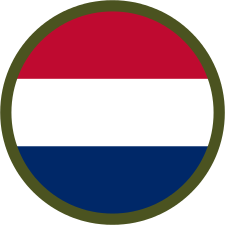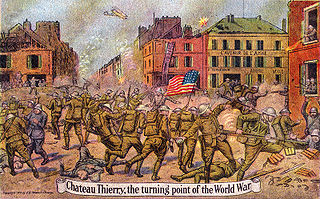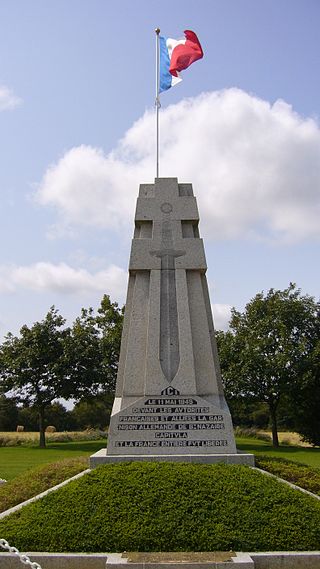
Nantes is a city in Loire-Atlantique of France on the Loire, 50 km (31 mi) from the Atlantic coast. The city is the sixth largest in France, with a population of 320,732 in Nantes proper and a metropolitan area of nearly 1 million inhabitants (2020). With Saint-Nazaire, a seaport on the Loire estuary, Nantes forms one of the main north-western French metropolitan agglomerations.

The American Expeditionary Forces (AEF) was a formation of the United States Armed Forces on the Western Front during World War I, comprised mostly of units from the U.S. Army. The AEF was established on July 5, 1917, in France under the command of then-Major General John J. Pershing. It fought alongside French Army, British Army, Canadian Army, British Indian Army, New Zealand Army and Australian Army units against the Imperial German Army. A small number of AEF troops also fought alongside Italian Army units in 1918 against the Austro-Hungarian Army. The AEF helped the French Army on the Western Front during the Aisne Offensive in the summer of 1918, and fought its major actions in the Battle of Saint-Mihiel and the Meuse-Argonne Offensive in the latter part of 1918.

Gertrude Vanderbilt Whitney was an American sculptor, art patron and collector, and founder in 1931 of the Whitney Museum of American Art in New York City. She was a prominent social figure and hostess, who was born into the wealthy Vanderbilt family and married into the Whitney family.

Saint-Nazaire is a commune in the Loire-Atlantique department in western France, in traditional Brittany.

Jo Davidson was an American sculptor. Although he specialized in realistic, intense portrait busts, Davidson did not require his subjects to formally pose for him; rather, he observed and spoke with them. He worked primarily with clay, while the final products were typically cast in terra-cotta or bronze, or carved from marble.

The Battle of Château-Thierry was fought on July 18, 1918 and was one of the first actions of the American Expeditionary Forces (AEF) under General John J. Pershing. It was a battle in World War I as part of the Second Battle of the Marne, initially prompted by a German Spring Offensive. German and local actions at Château-Thierry recommenced on May 31 to July 22, 1918, against the AEF, an American Expeditionary Force, consisting of troops from both the United States Army and Marine Corps units. These units were the newest troops on the front in France and just barely out of training.
The Fontainebleau Schools were founded in 1921, and consist of two schools: The American Conservatory, and the School of Fine Arts at Fontainebleau.

Mitchel Square Park is a small urban park in the Washington Heights neighborhood of the New York City borough of Manhattan. It is a two part, triangle-shaped park formed by the intersection of Saint Nicholas Avenue, Broadway and 167th Street.

Seated Lincoln is a 1911 sculpture by Gutzon Borglum, located next to the Essex County Courthouse in Newark, Essex County, New Jersey. It was added to the National Register of Historic Places on March 30, 1995, for its significance in art.

John J. Pershing General of the Armies, is a public artwork by American artist Robert White, located at Pershing Park in Washington, D.C., United States. John J. Pershing General of the Armies was originally surveyed as part of the Smithsonian's Save Outdoor Sculpture! survey in 1994. The monument is a tribute to United States Army general John J. Pershing.

André-César Vermare was a French sculptor, known for his war memorials and monuments.

The Services of Supply was the support chain of the American Expeditionary Forces in France, England, Italy and the Netherlands during World War I. It was disbanded on August 31, 1919, in France.

The Washington Heights-Inwood War Memorial, also known as the Inwood Monument, is a World War I (WWI) memorial monument sculpted by Gertrude Vanderbilt Whitney, with a base by Albert Randolph Ross. It is located at the intersection of Broadway and Saint Nicholas Avenue between 167th and 168th Streets in Mitchel Square Park, New York City, New York.

The Saint-Nazaire Pocket was an Atlantic pocket that existed from August 1944 until 11 May 1945 and was formed by the withdrawal of German troops from Loire-Inférieure during the liberation of the department by the allied forces. It was centred around the port and the submarine base of Saint-Nazaire and extended to the east as far as Saint-Omer-de-Blain and from La Roche-Bernard in the north to Pornic in the south.
The Bank of England War Memorial, in the internal Garden Court at the headquarters of the Bank of England in the City of London, commemorates the bank's staff who were killed while serving in the First World War and Second World War. It includes a bronze sculpture by Richard Reginald Goulden portraying Saint Christopher carrying the Christ Child. It became a Grade II listed building in 2017. The surrounding buildings of the bank are separately listed at Grade I.
Serpent d'océan is a work by artist Huang Yong Ping. Depicting a long sea serpent skeleton, it is installed in the intertidal zone at Saint-Brevin-les-Pins, Loire-Atlantique, France.















